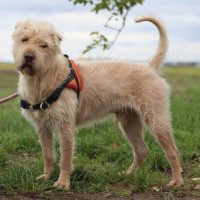 |
Griffon-Pei |
|
He is not recognized by the F.C.I. |
Origin |
Belgium <> China -> U.S.A. | |
Translation |
Francis Vandersteen |
A brief presentation of the Griffon-Pei |
| The Griffon-Pei is an adorable cross between the Brussels Griffon and the Chinese Shar Pei. Because the Griffon Bruxellois is a toy breed and the Chinese Shar Pei is a large breed, the Griffon-Pei is generally a small to medium-sized dog. They are good pets that make excellent watchdogs, but they may not be the best for homes with children. The Griffon-Pei does, however, love other pets, including cats, and they can get on well with other dogs in the dog park if well socialized. These dogs have a short to medium dense and sometimes stiff coat. The softness of the coat depends on whether the Brussels Griffon parent was a smooth-coated or rough-coated type. |
History of the Griffon-Pei |
| The Griffon-Pei is a modern dog with little documentation. The history of its parents can help to understand its instincts and background: the Griffon Bruxellois and the Shar Pei. |
A little of the Brussels Griffon |
||
| The Brussels Griffon dates back to the 1800s, when this small Terrier-like breed was used to hunt and kill mice and rats in Brussels, Belgium. They were particularly common in the stables where cab horses were kept, and cab drivers kept the dogs with them while driving to use them as a deterrent against theft. The breed was created from the English Toy Spaniel, where it got its big eyes, the Affenpinscher, where it got its stiff coat, and the Pug, where it got its dark muzzle and amusing expressions. The smooth-coated Griffon Bruxellois is also thought to be related to the Yorkshire Terrier. The breed standard was developed in Europe in 1883 and they began to be shown in competitions in 1889. The Queen Consort of the Belgians, Marie Henriette, really loved the breed and owned several. The American Kennel Club (AKC) began recognizing the Brussels Griffon in 1910, making it the 97th most popular dog breed. | ||
 |
||
| Standard of the Brussels Griffon | ||
A little of the Shar Pei |
||
| The Chinese Shar Pei originated in China and was used as a farm dog. Their images have been found on pottery dating back to 206 BC, making them one of the oldest Chinese breeds. Some of their talents included hunting vermin, raising livestock and guarding the house. The Chinese believed that the breed's dark mouth and wrinkled skin could ward off evil spirits. When the population of these dogs began to dwindle, a Hong Kong businessman named Matgo Law drew attention to these beautiful animals by featuring his in American magazines. They were officially recognized by the AKC in 1992 and are now the 61st most popular dog breed in America. | ||
 |
||
| Standard of the Shar Pei |
Appearance of the Griffon-Pei |
| Your Griffon-Pei has large, curious brown eyes, a black nose and may have a blue tongue and loose skin like the Chinese Shar Pei. Their coats can come in many different colors such as black, brown, red, cream, fawn and brindle. The Griffon-Pei has a small, round head with a short muzzle, which can cause your dog to develop brachycephalic syndrome, a respiratory problem that can cause severe breathing difficulties in some dogs. Therefore, it's important that you take your dog to see a veterinary care provider as soon as you notice it. They have strong, muscular legs and a rectangular body with a short tail that curls over their back. |
Temperament of the Griffon-Pei |
| This breed is adorable and friendly, but doesn't do well in a home with young children. In fact, they will need to be supervised with children of any age, as they tend to become lively if teased or aggravated. The Griffon-Pei loves other pets and gets on well with other dogs in the dog park as long as they are socialized early. Although they are highly intelligent dogs, they are also stubborn and can take a little extra time and patience when training. This breed is fearless and makes an excellent watchdog, and will take on dogs 10 times their size. |
Needs and activities of the Griffon-Pei |
| This breed has moderate energy levels and can even be lazy at times, so you may need to do something special to encourage it to exercise. A long walk in the morning and evening accompanied by a game of fetch or a trip to the dog park can be the perfect daily activity regime. He may also enjoy playing Frisbee, swimming or hiking in your local park. He'll need to be kept on a leash, however, as he may decide to chase squirrels or rabbits. Another activity he may enjoy is agility training, for which this breed is very good. |
Maintenance of the Griffon-Pei |
| If your Griffon-Pei has a smooth coat, it should be brushed daily with a pincushion brush. You should also brush his beard and moustache with a metal comb if necessary. If he tends to tangle, you may also need to use a detangler from time to time. If your dog has a stiff coat, it will need to be stripped with a special tool once every few months, or you can do it by hand, simply removing dead hairs. You need to remove them by the root, so you shouldn't do it with clippers. You should also clean his ears once a week and clip his nails if necessary. |






 English (United Kingdom)
English (United Kingdom)